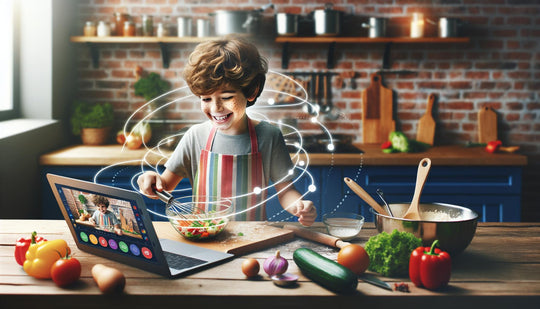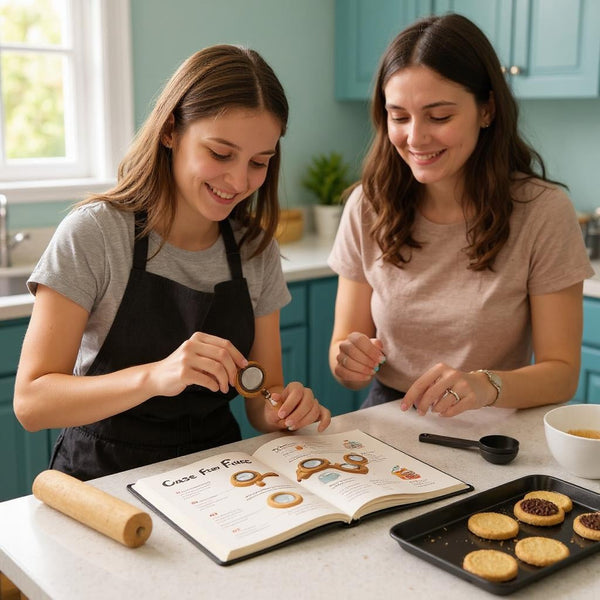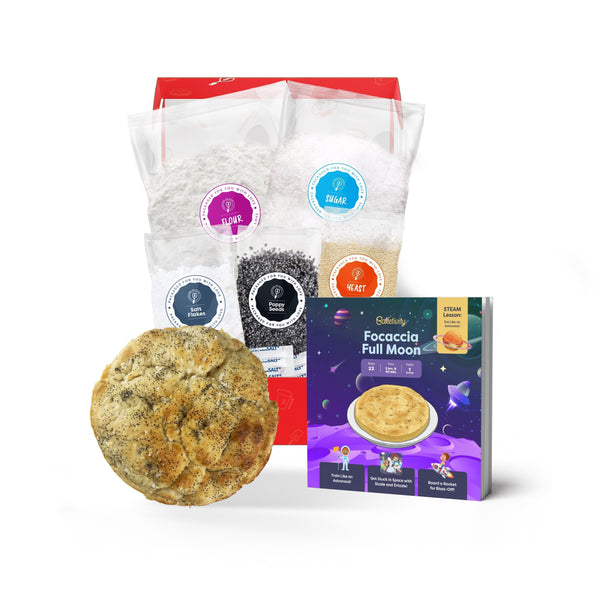Teaching kids to cook has never been more fun or accessible. With virtual cooking classes, children can now discover the joys of creating delicious meals right from our home kitchens. Parents love these online sessions because they combine entertainment with valuable life skills.
We understand that finding safe and engaging activities for kids can be challenging. That's why virtual cooking classes have become a popular choice for families looking to spark creativity and confidence in their young chefs. These interactive sessions let kids learn essential kitchen skills while connecting with other budding cooks their age.
Key Takeaways
- Virtual cooking classes provide a safe, interactive way for kids aged 6-14 to learn essential kitchen skills from home while developing life skills like math, reading, and time management
- Parents should ensure proper equipment including basic kitchen tools (measuring cups, child-safe knives, mixing bowls) and tech setup (stable internet, device with camera, good lighting) for optimal learning
- Age-appropriate classes are structured into three levels: beginners (6-8 years), intermediate (9-11 years), and advanced (12-14 years), with session lengths ranging from 30-60 minutes
- Safety is paramount - parents need to provide appropriate supervision based on age group and ensure proper kitchen safety protocols are followed during virtual sessions
- Interactive elements like digital demonstrations, real-time feedback, virtual competitions, and themed recipes keep children engaged while learning
- Beyond cooking skills, these classes teach valuable lessons in math, science, cultural awareness, and global food traditions through hands-on learning experiences
Benefits of Virtual Cooking Classes for Kids
Virtual cooking classes transform kitchen skills into engaging digital adventures for children ages 6-12. These interactive sessions combine entertainment with education in a structured online format.
Life Skills Development
Online cooking classes teach kids essential abilities beyond food preparation. Children learn measurement math through portioning ingredients, practice reading comprehension with recipes, and develop time management by coordinating multiple cooking steps. The classes boost independence as kids:
- Master basic kitchen safety protocols
- Practice following multi-step instructions
- Gain confidence in decision making
- Develop organizational habits
- Learn nutritional awareness
- Improve communication skills
Safe Learning Environment
Virtual cooking platforms create secure spaces for children to explore culinary skills from home. Kids can:
- Cook with adult supervision in familiar surroundings
- Learn at their own pace without peer pressure
- Practice techniques using child-safe tools
- Make mistakes without embarrassment
- Participate from allergy-safe environments
- Access recorded sessions for review
A home kitchen setting allows parents to monitor progress while giving children room to grow. The digital format eliminates common classroom distractions like crowding or competing for ingredients. Each student receives equal attention through split-screen demonstrations and individual feedback from instructors.
| Safety Feature | Benefit |
|---|---|
| Parent Presence | Immediate supervision and support |
| Familiar Kitchen | Reduced anxiety and stress |
| Individual Workspace | Better focus and concentration |
| Digital Interface | No physical contact risks |
| Recorded Sessions | Reference for proper techniques |
Essential Equipment for Online Cooking Sessions
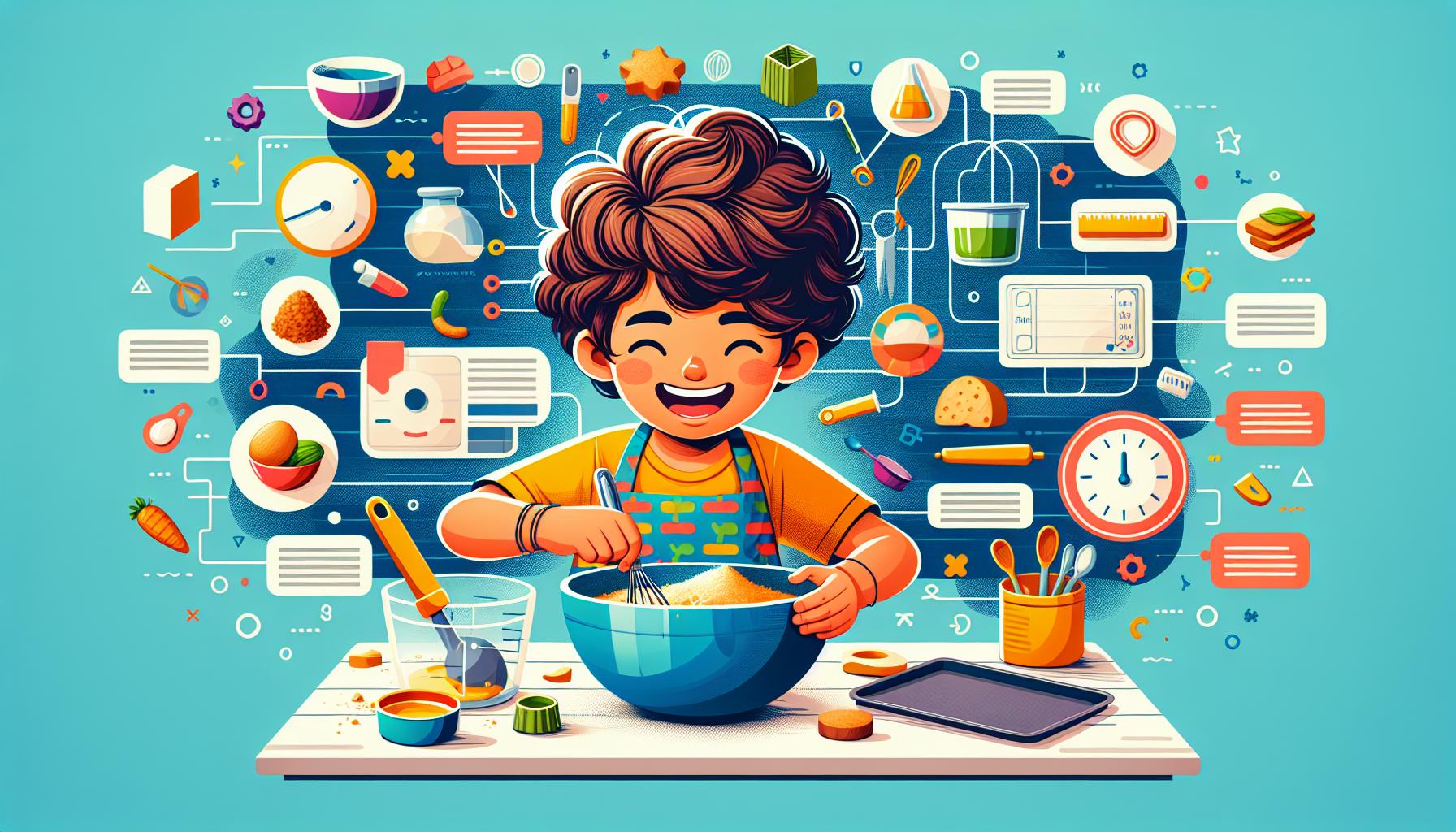
Virtual cooking classes require specific kitchen tools and technology setup to create an optimal learning environment for kids. Here's what parents need to prepare before their children join online cooking sessions.
Basic Kitchen Tools
- Measuring cups and spoons for accurate ingredient portions
- 2 mixing bowls (medium and large) for combining ingredients
- Child-safe knife set with rounded tips
- Non-slip cutting board with rubber grip
- Heat-resistant silicone spatula and wooden spoons
- Cookie sheet and 9x13 baking pan
- Colorful kitchen timer for tracking cooking times
- 4-piece prep bowl set for organizing ingredients
- Clean kitchen towels and paper towels
- Plastic zip bags for storing leftovers
- Stable internet connection (minimum 5 Mbps upload speed)
- Laptop or tablet with built-in camera
- Device stand or holder for hands-free viewing
- External speakers or headphones for clear audio
- Well-lit kitchen counter or workspace
- Clean background area visible on camera
- Backup power source for devices
- Digital kitchen scale for precise measurements
- Kitchen counter extension cord for device charging
- Adjustable device height stand for different cooking angles
A digital thermometer and oven mitts complement these tools by adding safety measures during cooking sessions. Each tool serves multiple purposes throughout different recipes, maximizing their value in virtual classes.
The technology setup creates clear communication between instructor and student when positioned correctly. Parents can test the video setup before class starts by checking camera angles and lighting conditions.
Top Virtual Cooking Programs for Children
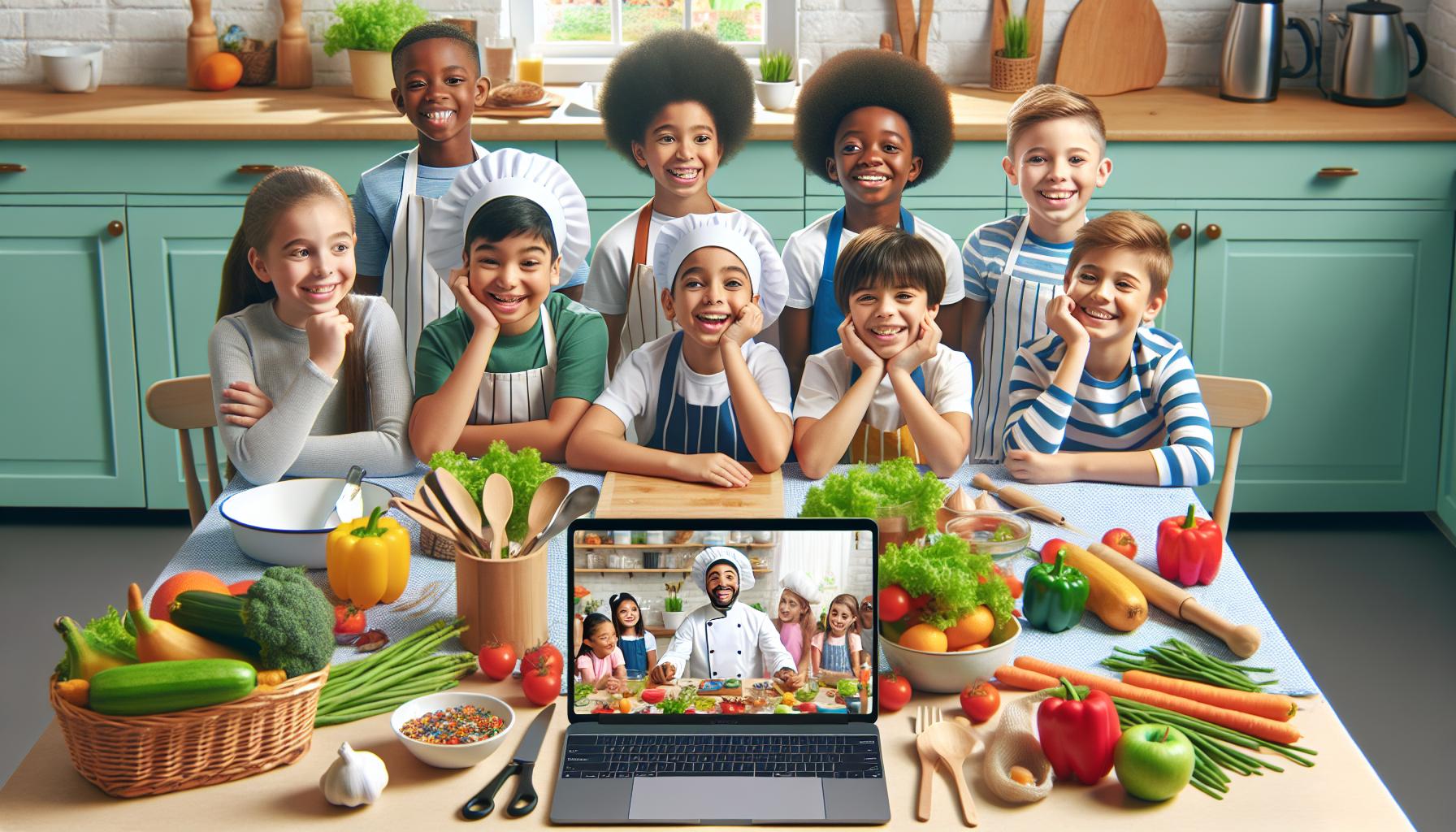
Virtual cooking programs offer structured learning paths that match children's developmental stages with engaging culinary activities. These online classes combine entertainment with education through specialized platforms designed for young chefs.
Age-Appropriate Class Options
Online cooking programs divide classes into three main age groups: 6-8 years, 9-11 years and 12-14 years. Each level incorporates age-specific skills:
- Beginner Classes (6-8 years):
- Basic mixing and measuring
- Simple no-cook recipes
- Kitchen safety fundamentals
- 30-minute session length
- Intermediate Classes (9-11 years):
- Stovetop cooking with supervision
- Multi-step recipe execution
- Kitchen tool handling
- 45-minute session length
- Advanced Classes (12-14 years):
- Complex recipe preparation
- Menu planning skills
- Food science concepts
- 60-minute session length
Interactive Learning Platforms
Digital platforms enhance the cooking experience through multiple interactive features:
- Live Video Elements:
- Split-screen demonstrations
- Real-time instructor feedback
- Virtual hand-raising options
- Chat functionality
- Learning Tools:
- Digital recipe cards
- Progress tracking systems
- Achievement badges
- Recorded sessions for practice
- Engagement Features:
- Virtual cooking competitions
- Group cooking challenges
- Peer recipe sharing
- Weekly themed classes
Each platform includes built-in safety protocols with parent dashboards to monitor progress and participation. Class sizes remain limited to 10 students, creating an intimate learning environment where every child receives personal attention.
Safety Guidelines and Parent Supervision
Creating a secure cooking environment empowers kids to explore culinary skills with confidence during virtual classes. Parents play an essential role in maintaining safety standards while fostering independence.
Kitchen Safety Rules
- Place sharp objects like knives in designated safe zones away from the cooking area
- Keep pot handles turned inward on the stovetop to prevent accidental spills
- Use oven mitts when handling hot items such as baking sheets or pans
- Clean spills immediately to avoid slipping hazards
- Store cleaning products in a separate cabinet from cooking ingredients
- Maintain a clear workspace by wiping counters before cooking starts
- Keep a fire extinguisher accessible in case of emergencies
- Use non-slip mats near sinks or wet areas
- Check that electrical appliances are unplugged when not in use
- Position yourself within arm's reach during knife usage or stovetop cooking
- Review recipe instructions together before class starts
- Help measure ingredients for recipes requiring precise amounts
- Monitor temperature settings on appliances
- Demonstrate proper hand-washing techniques before food handling
- Stay nearby during equipment operation like mixers or blenders
- Guide children through cleanup procedures after cooking
- Watch for proper ingredient storage and food safety practices
- Assist with reading temperature gauges for meat doneness
- Practice positive reinforcement when kids follow safety protocols
| Age Group | Recommended Supervision Level |
|---|---|
| 6-8 years | Direct supervision at all times |
| 9-11 years | Close monitoring with occasional hands-on help |
| 12-14 years | Periodic checking with increased independence |
Making Virtual Cooking Classes Engaging
Virtual cooking classes captivate young chefs through interactive elements that transform kitchen skills into exciting digital adventures. These online sessions blend entertainment with education to keep children focused throughout each lesson.
Fun Recipe Selection
Age-appropriate recipes spark children's interest in cooking while building essential skills. We incorporate colorful ingredients like rainbow fruit kebabs for ages 6-8 or pizza faces with vegetable toppings for ages 9-11. Kid-friendly themes connect cooking to their interests:
- Seasonal recipes (Halloween monster cookies, Valentine's heart-shaped sandwiches)
- Movie-inspired dishes (superhero smoothies, princess pancakes)
- Global cuisine adventures (Italian pasta, Mexican tacos)
- Science-based recipes (color-changing lemonade, edible slime)
Interactive Teaching Methods
Digital engagement tools transform standard cooking instructions into memorable learning experiences. Our instructors use these techniques to maintain student interest:
- Virtual high-fives celebrate cooking milestones
- Digital polls let students vote on ingredient substitutions
- Screen sharing displays step-by-step technique demonstrations
- Breakout rooms enable small group cooking challenges
- Live quizzes test kitchen safety knowledge
- Digital badges reward completed recipes
Active participation strategies include:
- Show-and-tell segments for finished dishes
- Virtual taste tests with real-time reactions
- Dance breaks during mixing activities
- Student-led recipe modifications
- Picture-in-picture views to showcase techniques
| Age Group | Average Engagement Time | Preferred Activity Type |
|---|---|---|
| 6-8 years | 30 minutes | Hands-on demonstrations |
| 9-11 years | 45 minutes | Cooking challenges |
| 12-14 years | 60 minutes | Recipe customization |
What Kids Learn Beyond Cooking
Virtual cooking classes equip children with skills that extend far beyond the kitchen counter. These interactive sessions create opportunities for comprehensive learning through hands-on experiences.
Math and Science Connections
Kitchen activities naturally incorporate mathematical concepts through measuring ingredients, scaling recipes, and understanding proportions. Children practice fractions while dividing recipes in half or doubling quantities. Temperature control introduces basic physics principles, like how heat transforms ingredients during baking. Time management skills develop as kids calculate cooking durations and coordinate multiple recipe steps.
Common math applications include:
- Converting measurements (cups to tablespoons)
- Counting ingredients for multiple servings
- Adding fractions for recipe adjustments
- Understanding weight versus volume
Science concepts emerge through:
- Observing chemical reactions in baking
- Learning about heat transfer methods
- Exploring food preservation techniques
- Testing hypothesis through recipe experiments
Cultural Food Exploration
Virtual cooking classes introduce children to diverse cuisines from different regions and cultures. Kids learn about traditional ingredients, cooking methods, and cultural significance of various dishes. Each recipe becomes a gateway to understanding global traditions and food histories.
Cultural learning elements include:
- Traditional cooking techniques from different regions
- Stories behind heritage recipes
- Seasonal celebrations and their special dishes
- Regional ingredient variations
Interactive components enhance cultural understanding through:
- Virtual visits to international markets
- Exploring spice combinations
- Learning cultural eating customs
- Discovering ingredient origins and histories
| Cultural Element | Learning Outcome |
|---|---|
| Recipe Origins | Historical context |
| Cooking Methods | Regional techniques |
| Ingredients | Geographic understanding |
| Food Traditions | Cultural awareness |
Conclusion
Virtual cooking classes have revolutionized how we teach culinary skills to young minds. As we've explored their numerous benefits it's clear these digital platforms offer more than just cooking instruction. They provide a safe engaging environment where kids can develop confidence independence and essential life skills.
We believe that investing in virtual cooking education for children is a step toward nurturing well-rounded individuals who understand the joy of cooking and its connection to culture math and science. The combination of structured learning interactive features and safety-first approach makes these classes an invaluable resource for families looking to inspire their young chefs.
Frequently Asked Questions
What age groups are virtual cooking classes suitable for?
Virtual cooking classes are designed for children aged 6-14, typically divided into three groups: 6-8 years, 9-11 years, and 12-14 years. Each age group receives age-appropriate instruction, recipes, and activities tailored to their skill level and attention span.
How do virtual cooking classes ensure children's safety?
Safety is maintained through parent supervision, child-safe kitchen tools, structured safety guidelines, and limited class sizes. Parents have access to monitoring dashboards, and instructors provide clear safety instructions throughout each session. All activities are designed with age-appropriate safety considerations.
What equipment is needed for virtual cooking classes?
Basic kitchen tools, a stable internet connection, and a device with a camera (tablet, laptop, or computer) are essential. Additional requirements may include basic ingredients, measuring tools, and a clear workspace for food preparation.
How do virtual cooking classes maintain children's engagement?
Classes use interactive elements like virtual high-fives, live quizzes, show-and-tell segments, and virtual taste tests. Digital engagement tools, age-appropriate recipes, and split-screen demonstrations keep children interested and actively participating throughout the session.
What skills do children learn beyond cooking?
Children develop various skills including math (through measurements), reading comprehension, time management, and cultural awareness. They also learn science principles, organizational habits, decision-making skills, and gain confidence while working independently in the kitchen.
How long are virtual cooking class sessions?
Session lengths vary by age group but are typically designed to maintain optimal attention spans. Younger children (6-8) usually have shorter sessions, while older children (12-14) can participate in longer, more detailed cooking experiences.
Can parents participate in the virtual cooking classes?
Yes, parents are encouraged to supervise and can participate alongside their children. This allows for family bonding while ensuring safety and proper technique implementation during cooking activities.
How is individual attention provided in virtual classes?
Instructors use split-screen demonstrations and maintain small class sizes to ensure each student receives personal attention. They provide real-time feedback and can address individual questions through interactive video platforms.
